A content management system (CMS) is the engine behind every modern website and digital experience.
But as brands scale across websites, mobile apps, and digital touchpoints, traditional headless CMS platforms are hitting their limits.
That’s where the headless CMS takes over.
Unlike traditional CMSs that combine backend and frontend into a single system, a headless CMS decouples content from presentation.
This gives developers the freedom to build with modern frameworks, while marketers can create, organize, and publish content effortlessly.
In 2025, the headless CMS market is thriving offering platforms that are faster, more flexible, and tailored to omnichannel content delivery.
Whether you’re building a global enterprise site, an app based ecosystem, or a scalable SaaS platform, a headless CMS can give your business the speed, control, and future readiness it needs.
What Is a Headless CMS?
A headless CMS is a back end only content management system that manages, structures, and stores content separately from where it’s displayed.
Content is delivered via APIs (REST or GraphQL) to any platform whether it’s a website, mobile app, smartwatch, or IoT device.
In Simple Terms:
The backend stores and manages your content.
The frontend (your website or app) retrieves that content via API.
This separation gives teams flexibility to use any design framework or technology they prefer.
Why Businesses Love Headless CMS in 2025:
Deliver content seamlessly across multiple channels.
Maintain fast, scalable, and secure digital products.
Enable collaboration between developers and content creators.
Simplify content reuse across sites, apps, and microsites.
Stay future proof as technologies evolve.
Traditional vs. Headless CMS
| Traditional CMS | Headless CMS |
|---|---|
| Content tightly coupled with front end | Content delivered via APIs |
| Limited design flexibility | Full control over front end frameworks |
| Suitable for single channel websites | Built for multi channel and omnichannel |
| Harder to scale and optimize | Highly scalable and performance optimized |
10 Best Headless CMS Platforms in 2025
the top 10 headless CMS platforms leading the way in 2025 with in depth overviews, standout features, limitations, and pricing.
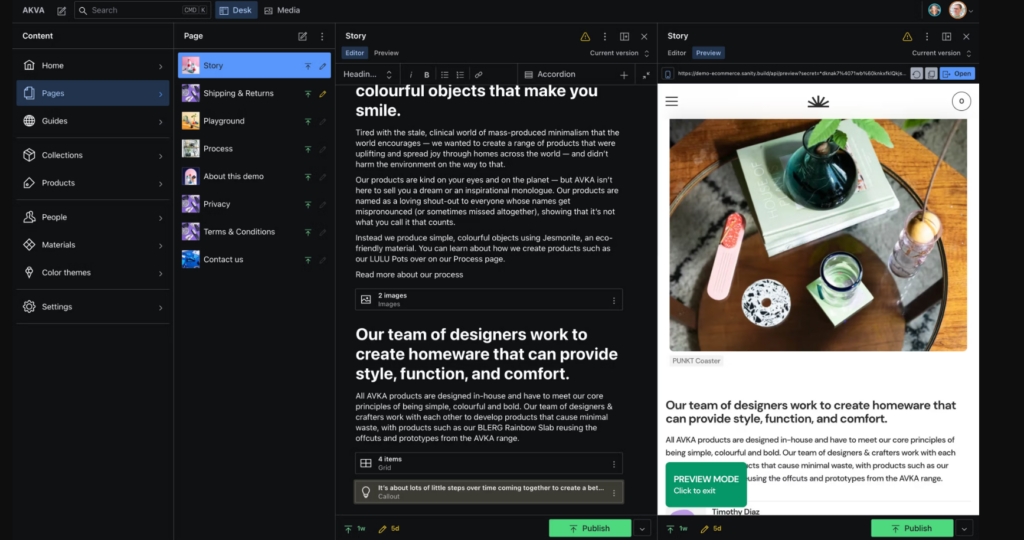
Overview
Sanity is an open source, cloud first headless CMS designed to give developers and editors maximum flexibility.
It treats content as structured data, allowing you to connect it seamlessly to any digital channel from web apps to e-commerce storefronts to IoT devices.
Sanity’s core differentiator is its Sanity Studio, a highly customizable content workspace built with React. This gives developers total control to define how editors interact with content while maintaining an intuitive, real time editing experience.
For marketing teams, its collaborative tools allow multiple users to edit, comment, and track changes live, making it ideal for distributed content operations.
It’s used by companies like Nike, Figma, and National Geographic proof of its scalability and developer first architecture.
Best Features
Real time collaboration and versioning.
Fully customizable Sanity Studio built with React.
REST, GraphQL, and GROQ query language support.
Extensive integration with frameworks like Next.js, Astro, and Gatsby.
Global CDN for fast content delivery.
Limitations
Requires some developer setup before non tech teams can use it effectively.
Certain advanced modules have a steeper learning curve.
Pricing
Free: Best for small projects or startups.
Pro: $99/month per project.
Team: $499/month per project.
Enterprise: Custom pricing with SLA and dedicated support.
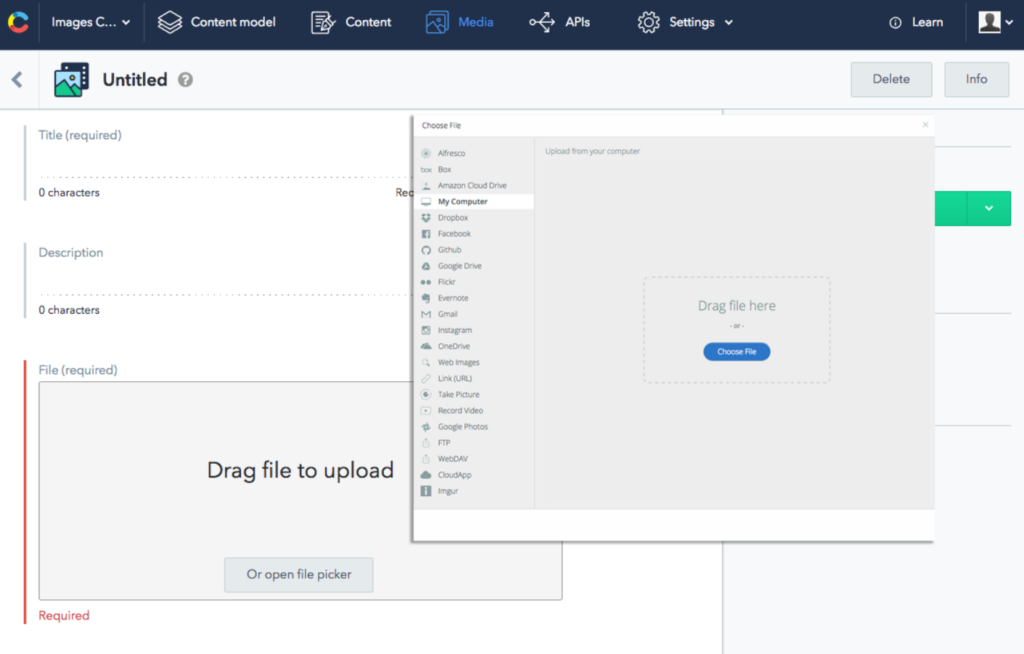
Overview
Contentful is the gold standard of enterprise grade headless CMS platforms, trusted by brands like IKEA, Spotify, and Vodafone.
Its content as a service model allows teams to manage, structure, and deliver content globally across multiple channels.
It’s built for scale, supporting multiple locales, environments, and teams. Developers can use either REST or GraphQL APIs, while marketers benefit from a user friendly interface, role based workflows, and real time editing.
Contentful’s powerful app marketplace also makes it highly extensible, integrating seamlessly with platforms like Shopify, Salesforce, and Figma.
Best Features
API first design with REST and GraphQL support.
Scalable environments for enterprise projects.
Customizable workflows and user permissions.
Integrates with hundreds of third party tools.
Strong global CDN and caching architecture.
Limitations
Expensive at scale with high API traffic.
Less visual editing flexibility than platforms like Storyblok.
Pricing
Free: Up to 10 users and 100K API calls/month.
Team: Around $300/month.
Enterprise: Custom pricing ($5,000–$70,000+/year).
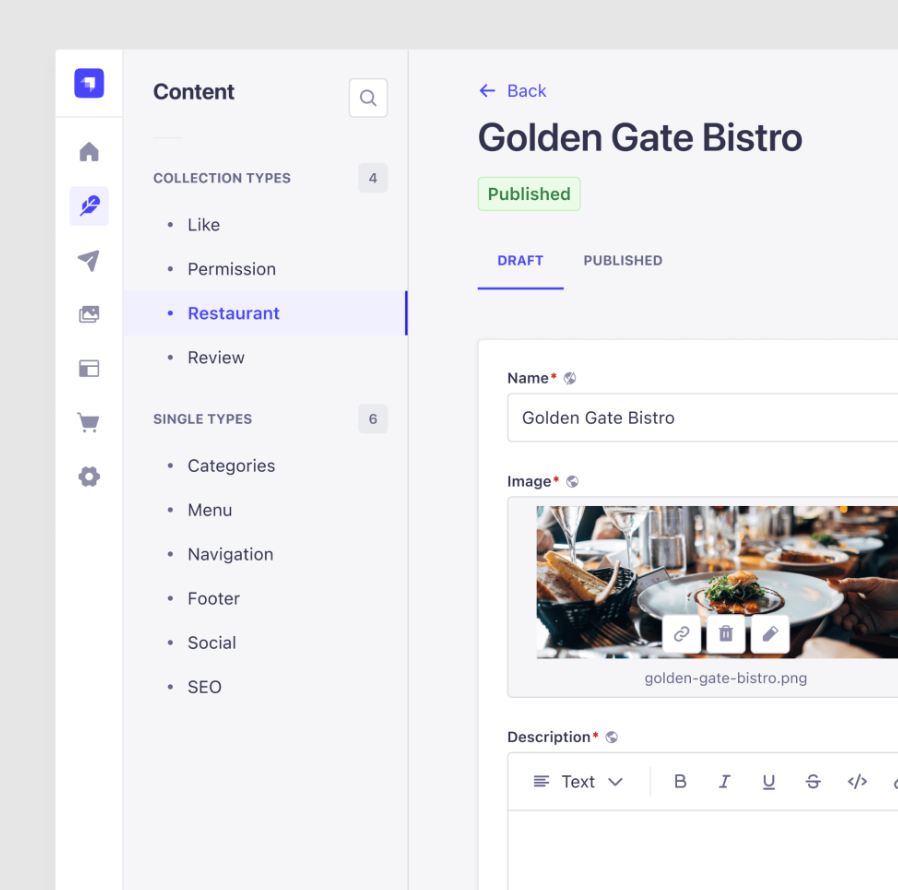
Overview
Strapi is one of the most popular open source headless CMS platforms on the market and for good reason.
Built on Node.js, Strapi provides developers with full control over their content architecture while remaining approachable for non technical users through its clean admin panel.
What sets Strapi apart is its developer first approach. It’s 100% JavaScript, meaning developers can easily extend APIs, build plugins, or integrate it into existing codebases.
You can self host it for complete infrastructure control or use Strapi Cloud to avoid maintenance overhead.
It’s perfect for agencies, startups, and enterprise teams who need flexibility, scalability, and open source freedom.
Best Features
REST and GraphQL APIs available out of the box.
Flexible content modelling and custom roles.
Rich plugin ecosystem to extend functionality.
Active community and detailed documentation.
Multilingual and localization support.
Limitations
Requires development knowledge to configure and scale.
Lacks native marketing workflow features (approvals, versioning).
Pricing
Self Hosted (Community): Free.
Cloud (Essential): $15/project/month.
Cloud (Pro): $75/project/month.
Cloud (Scale): $375/project/month.
Enterprise: Custom pricing.
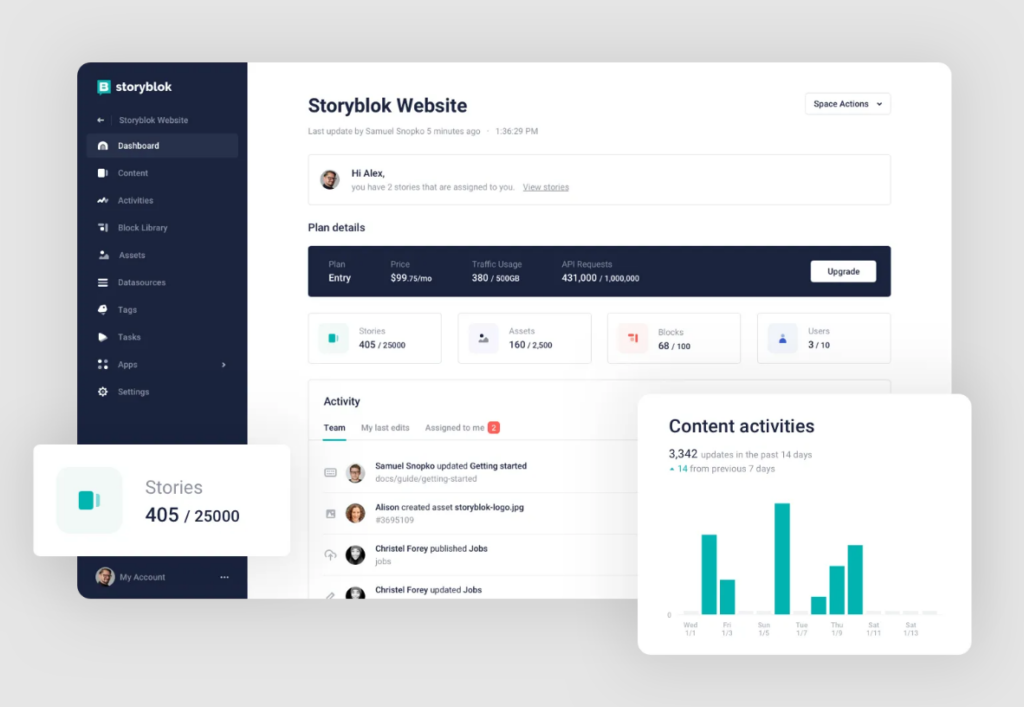
Overview
Storyblok is a hybrid headless CMS that bridges the gap between developers and marketers.
Its biggest strength is the visual editor, allowing marketers to create, preview, and publish content without needing developer support all while developers enjoy full control of the API driven backend.
Storyblok’s component based architecture (known as “Bloks”) encourages content reusability and consistency across digital platforms. It’s ideal for teams building multilingual websites, e-commerce stores, or global brand portals.
Best Features
Visual drag and drop editor with live preview.
Component based content structure for scalability.
Multi language and workflow management built in.
REST and GraphQL APIs with fast CDN delivery.
Integrations with Nuxt.js, Next.js, and React.
Limitations
Higher tier plans required for advanced features.
Visual UI may not appeal to developer only teams.
Pricing
Free Plan: For individuals and small projects.
Teams/Business: Custom pricing.
Enterprise: Tailored pricing with SLA.

Overview
Hygraph is the first fully GraphQL native CMS, purpose built for developers building high performance digital experiences.
Its modern approach focuses on flexible schemas, data relationships, and content federation, allowing organizations to bring multiple data sources into a single unified content layer.
Hygraph is ideal for enterprise teams using JAMstack or microservice architectures. It’s also developer friendly, offering a visual schema builder, powerful APIs, and custom resolvers for complex integrations.
Best Features
GraphQL native architecture for faster queries.
Custom schema builder and content federation.
Role based access control and audit logs.
Integrates easily with React, Vue, and Svelte.
Built in performance monitoring and security.
Limitations
Requires GraphQL knowledge for maximum benefit.
Costs can rise as API traffic scales.
Pricing
Free Hobby Plan.
Business Plans: $199–$899/month.
Enterprise: Custom pricing with SLAs.

Overview
Prismic offers a unique approach to headless CMS with its Slice based content architecture, which allows marketers to assemble pages from reusable “slices” designed by developers.
This model makes content creation fast, consistent, and brand safe especially for businesses managing many landing pages or marketing campaigns.
Its intuitive interface, flexible previews, and integration with modern frameworks make it ideal for small to mid sized marketing teams that still want developer flexibility.
Best Features
Slice Machine for modular content assembly.
REST and GraphQL APIs.
Scheduling, localization, and versioning tools.
Integrations with Next.js, Gatsby, and Nuxt.
Limitations
Advanced workflows require higher plans.
Governance and enterprise features limited.
Pricing
Free Starter Plan.
Team Plan: $7/user/month.
Enterprise: Custom pricing.
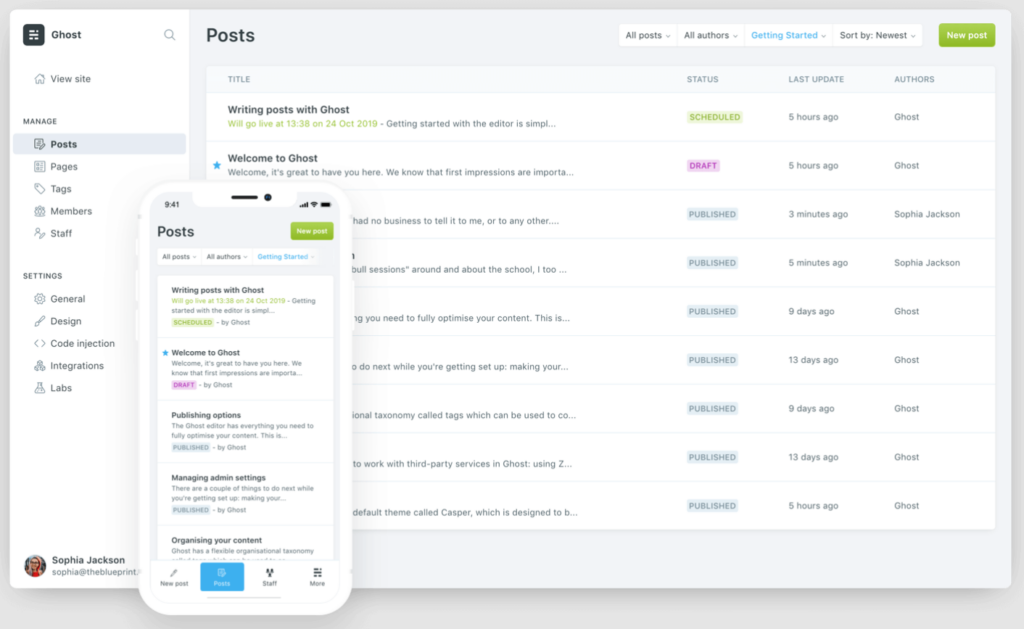
Overview
Ghost started as a minimalist blogging platform but has evolved into a modern headless CMS for publishers, newsletters, and content driven businesses.
It’s fully open source, lightweight, and incredibly fast making it a great choice for startups, media outlets, and creators.
Ghost supports membership and subscription features out of the box, along with built in SEO tools and newsletter distribution, eliminating the need for multiple platforms.
Best Features
Markdown based editor with content preview.
Native email and membership tools.
REST API for headless publishing.
Integrated analytics and SEO management.
Limitations
Not built for complex enterprise setups.
Fewer integrations compared to enterprise CMS platforms.
Pricing
Self hosted: Free.
Ghost(Pro):
- Starter: $9/month
- Creator: $25/month
- Team: $50/month
- Business: $200/month
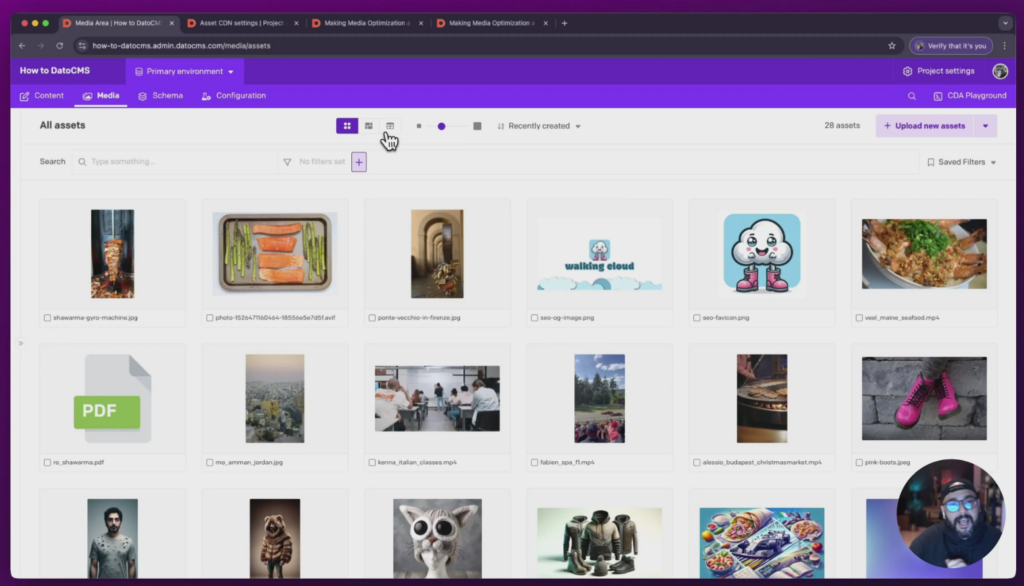
Overview
DatoCMS is built for modern web developers who prioritize speed and scalability.
With a focus on GraphQL APIs, image optimization, and real time updates, DatoCMS fits perfectly within JAMstack workflows.
It supports content localization, modular page structures, and integrates seamlessly with popular frameworks like Next.js and Gatsby. For editors, its UI is clean and easy to navigate.
Best Features
GraphQL based APIs with real time updates.
Global image CDN for optimized performance.
Localization support for multi language projects.
Webhooks for CI/CD integration.
Limitations
Smaller ecosystem than large CMS vendors.
Cost increases quickly with bandwidth and content volume.
Pricing
Free Developer Plan.
Pro Plan: $25/month.
Enterprise: Custom quote.
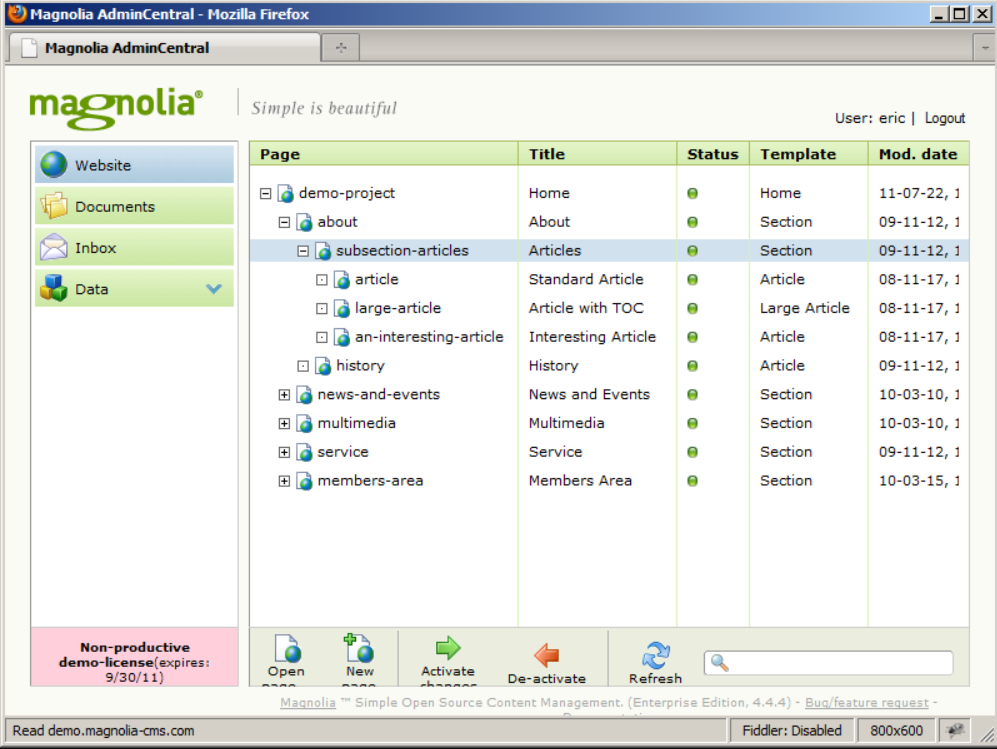
Overview
Magnolia is a powerful hybrid CMS that combines traditional WYSIWYG editing with modern headless APIs.
It’s trusted by enterprise organizations needing to manage complex, multi site, multi language digital experiences at scale.
Magnolia offers robust governance, personalization, and analytics tools ideal for large businesses transitioning from legacy CMS platforms.
Best Features
Multi site, multi language support.
Advanced workflows and version control.
Personalization and A/B testing tools.
Integration with Salesforce, Google Analytics, and Adobe.
Limitations
Expensive setup and licensing costs.
Requires experienced developers for customization.
Pricing
Open Source CMS: Free.
Self Hosted DXP: $3,000/month.
Cloud DXP: Custom pricing.
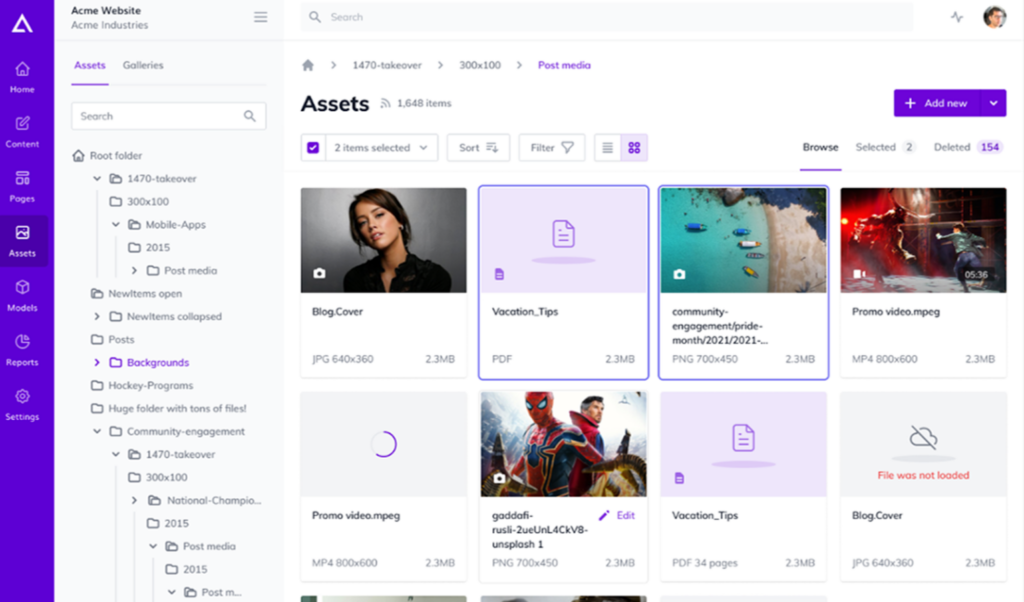
Overview
Agility CMS markets itself as one of the fastest headless CMS platforms available and it delivers.
It’s known for its speed, robust API, and strong customer support. Agility CMS also includes a page management system, bridging the gap between traditional and headless workflows.
It’s perfect for companies managing multi channel digital experiences who need flexibility, control, and reliability.
Best Features
Blazing fast API and CDN delivery.
Page management and shared content blocks.
E-commerce and multi channel publishing.
Dedicated onboarding and support.
Limitations
Search and filtering tools could be stronger.
Requires technical setup for advanced use.
Pricing
Starter: $1,249/month.
Pro: $2,499/month.
Enterprise: Custom pricing.
Summary Table
| CMS | Ideal For | Strength | Limitation | Starting Price |
|---|---|---|---|---|
| Sanity | Dev teams | Real time collaboration | Steep learning curve | Free |
| Strapi | Developers | Open source & flexible | Limited editor tools | Free |
| Contentful | Enterprises | Scalability & API power | High cost | $300/mo |
| Storyblok | Marketers + Devs | Visual editor | High tier costs | Free |
| Hygraph | GraphQL projects | Developer performance | Requires GraphQL skills | $199/mo |
| Prismic | Marketing teams | Slice-based pages | Limited enterprise tools | Free |
| Ghost | Publishers | Membership & blog tools | Limited integrations | Free |
| DatoCMS | JAMstack devs | Speed & performance | Smaller community | Free |
| Magnolia | Enterprises | Hybrid architecture | Complex setup | $3,000/mo |
| Agility CMS | Multi channel brands | Speed & scalability | Costly | $1,249/mo |
Enozom’s Expertise in Headless CMS Development
At Enozom, our development team has extensive experience in building and integrating custom CMS websites using headless platforms. Over the years, we’ve worked with leading technologies, helping businesses create fast, scalable, and future ready digital experiences. Our developers understand how to structure content, optimize APIs, and connect front end frameworks like React, Next.js, and Vue to deliver high performing websites and applications. Whether it’s developing a new CMS from the ground up or migrating an existing system to a headless architecture, Enozom ensures every project is secure, flexible, and tailored to your business goals.
FAQ
What is a headless CMS used for?
A headless CMS is used to manage and distribute content across multiple digital channels such as websites, mobile apps, smart devices, and digital displays.
It separates the backend (content storage and management) from the frontend (design and presentation), giving developers full freedom to build with any technology stack while allowing content editors to manage text, images, and media from one place.
What’s the difference between a traditional CMS and a headless CMS?
A traditional CMS (like WordPress or Joomla) combines both the content management backend and the website frontend in one system.
A headless CMS, however, removes the “head” the presentation layer and delivers content via APIs to any device or platform.
This makes it faster, more flexible, and ideal for businesses managing multiple channels.
Is a headless CMS better for SEO?
Yes a headless CMS can improve SEO when configured correctly.
Because it allows for faster page load times, cleaner URLs, and greater control over metadata, it can enhance performance metrics that Google prioritizes.
However, SEO success depends on how the front-end is built frameworks like Next.js, Gatsby, or Nuxt.js are often used to optimize SEO in headless environments.
What are the main benefits of using a headless CMS?
Key benefits include:
Flexibility: Deliver content anywhere web, mobile, or IoT.
Performance: API driven delivery ensures faster sites.
Scalability: Easily manage growing content and audiences.
Future proofing: Adapt to new technologies without rebuilding your CMS.
Collaboration: Developers and marketers can work independently but in sync.
What are the drawbacks of a headless CMS?
While powerful, a headless CMS comes with some trade offs:
Requires developer setup not always plug-and-play.
Costs may rise with API usage or enterprise features.
No built in frontend requires a separate UI or website framework.
However, these are outweighed by the long term scalability and control it provides.
Which is the best headless CMS for small businesses?
For small teams or startups, Strapi, Sanity, and Prismic are great options.
They’re affordable (or even free), open source, and easy to scale as your business grows.
They also integrate well with modern web frameworks and have intuitive interfaces for content creators.
Which headless CMS is best for large enterprises?
For enterprise level organizations, Contentful, Hygraph, Magnolia, and Agility CMS are top tier choices.
They offer advanced governance, localization, security, and scalability needed for managing multi brand, multi language, or multi site environments.
Can I migrate from WordPress to a headless CMS?
Absolutely.
Many companies migrate from WordPress to headless CMSs to improve performance, scalability, and flexibility.
You can continue to use WordPress as a “headless backend” (decoupled WordPress) or migrate your content entirely to a dedicated headless CMS like Contentful, Sanity, or Strapi all of which offer migration tools or APIs for importing data.
Is a headless CMS suitable for e-commerce?
Yes a headless CMS is excellent for e-commerce websites.
It allows you to connect your product catalog, marketing content, and customer experience seamlessly across multiple channels (web, app, kiosk, or POS).
Platforms like Storyblok, Hygraph, and Agility CMS are especially strong in e-commerce use cases.
How do I choose the right headless CMS for my business?
Here’s what to consider:
Team expertise: Do you have developers or need low code tools?
Project scale: Small site, SaaS platform, or enterprise ecosystem?
Integrations: Does it connect with your CRM, e-commerce, or analytics stack?
Budget: Pricing varies from free (Strapi, Sanity) to enterprise level (Contentful, Magnolia).
Localization & scalability: If you’re targeting multiple regions, pick one with strong i18n and CDN support.
How much does a headless CMS cost?
Pricing depends on usage, features, and hosting.
Free & open source: Strapi, Sanity, Prismic.
Mid tier SaaS: Storyblok ($50–$400/month).
Enterprise plans: Contentful, Hygraph, Magnolia (from $3,000–$10,000/month).
Always assess API call limits, seat counts, and CDN usage before choosing a plan.
Can Enozom integrate a headless CMS into my business?
Yes!
Enozom’s web development team specializes in building custom web and SaaS platforms using headless CMSs like Strapi, Sanity, Contentful, and Storyblok.
We help businesses design flexible, scalable, and future ready architectures tailored to their goals.
If you’re ready to modernize your digital presence
Contact Enozom today to discuss your headless CMS project!
